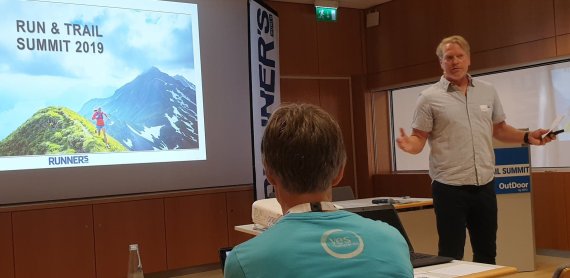
Running expert Urs Weber waited briefly before introducing his colleagues: "You see, we are very active", said the editor of the magazine "Runner's World" with a smile, while pictures of people in running clothes popped up behind him. "Every Wednesday we run together, but every lunch break is a running break for us anyway."
At OutDoor by ISPO 2019, the Runner's World editorial team around Weber hosted the Run & Trail Summit for the second time. Weber, who guided through the program, like he does at the traditional running shoe symposium of ISPO Munich, presented the most important figures about trail running. The central statement: "At the moment, all the big brands rely on Trail, Adidas with Terrex, Nike is joining in, but an old-established outdoor brand like The North Face also does a lot."
Above all, these companies see great potential in the still growing sector. Interest in trail running has increased considerably in recent years, Weber explains. 32 percent of the readers of his magazine, the direct runner community, recently showed their interest in participating in trail running competitions in the annual survey. "In the past five years, the value has increased by eight percent," says Weber. About 9000 people take part in the survey every year.
Therefore, the topic of running in general, and trail running in particular, will once again be an important part of OutDoor by ISPO. After all, diversity is increasing in the industry in particular. In addition, local brands such as Salomon or Icebug venture from the trail onto the road, On goes the other way, as Adidas did with Terrex. Meanwhile 43 brands offer trail running shoes, a dozen are in the starting blocks (such as True Motion or UYN).

At the same time, the experts are observing an "equipment phenomenon", as Weber puts it, running has become a sport of equipment. Instead of going on a running lap with any sportswear as in the past, "runners increasingly want to define themselves as runners". They spend around 300 euros per year for equipment, the most recent increase in the purchase of wearables being GPS and pulse watches (20 percent, previous year 14 percent). The Runner's World reader has an average of 5.5 pairs of running shoes, at least one pair of which are trail running shoes.
Nevertheless, Weber believes that the so-called boom must be "properly classified". 84 percent of the readers take to the streets, so 32 percent of the trail runners have less of an effect.
Christoph Görner of the Lauf-Profis, the association of around 120 sports retailers in Germany, agrees with Weber. After all, trail running does not have the perhaps presumed share in the dealers' turnover yet: Running shoe dealers only make five percent with trail running products so far. But Görner, who recently held a number of trail events, also observes that the community is really growing all the time. "As a trader, you have to invite people and take them with you, because the interest is there in any case," says Weber.
The most important lever for this is actually the dealers. In the survey, 84 percent stated that they buy their running clothes in specialist sports shops, 79 percent even in specialist running shops. "That's a lot," Weber says. Online shopping, however, is right on the heels of retailers (79 percent, multiple answers possible).
- Awards
- Mountain sports
- Bike
- Fitness
- Health
- ISPO Munich
- Running
- Brands
- Sustainability
- Olympia
- OutDoor
- Promotion
- Sports Business
- Textrends
- Triathlon
- Water sports
- Winter sports
- eSports
- SportsTech
- OutDoor by ISPO
- Heroes
- Transformation
- Sport Fashion
- Urban Culture
- Challenges of a CEO
- Trade fairs
- Sports
- Find the Balance
- Product reviews
- Newsletter Exclusive Area
- Magazine





